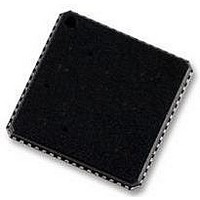ADSP-BF592KCPZ Analog Devices Inc, ADSP-BF592KCPZ Datasheet - Page 6

ADSP-BF592KCPZ
Manufacturer Part Number
ADSP-BF592KCPZ
Description
58T4522
Manufacturer
Analog Devices Inc
Specifications of ADSP-BF592KCPZ
Operating Temperature (min)
0C
Operating Temperature (max)
70C
Operating Temperature Classification
Commercial
Mounting
Surface Mount
Pin Count
64
Rohs Compliant
YES
Frequency
400MHz
Embedded Interface Type
PPI, SPI, UART
No. Of I/o's
32
Operating Temperature Range
0°C To +70°C
Digital Ic Case Style
LFCSP
No. Of Pins
64
Core Supply Voltage
1.4V
Lead Free Status / RoHS Status
Compliant
Available stocks
Company
Part Number
Manufacturer
Quantity
Price
Company:
Part Number:
ADSP-BF592KCPZ-2
Manufacturer:
BROADCOM
Quantity:
154
ADSP-BF592
Each event type has an associated register to hold the return
address and an associated return-from-event instruction. When
an event is triggered, the state of the processor is saved on the
supervisor stack.
The processor event controller consists of two stages: the core
event controller (CEC) and the system interrupt controller
(SIC). The core event controller works with the system interrupt
controller to prioritize and control all system events. Conceptu-
ally, interrupts from the peripherals enter into the SIC and are
then routed directly into the general-purpose interrupts of the
CEC.
Core Event Controller (CEC)
The CEC supports nine general-purpose interrupts (IVG15–7),
in addition to the dedicated interrupt and exception events. Of
these general-purpose interrupts, the two lowest-priority
interrupts (IVG15–14) are recommended to be reserved for
software interrupt handlers, leaving seven prioritized interrupt
inputs to support the peripherals of the processor.
describes the inputs to the CEC, identifies their names in the
event vector table (EVT), and lists their priorities.
System Interrupt Controller (SIC)
The system interrupt controller provides the mapping and rout-
ing of events from the many peripheral interrupt sources to the
prioritized general-purpose interrupt inputs of the CEC.
Although the processor provides a default mapping, the user
can alter the mappings and priorities of interrupt events by writ-
ing the appropriate values into the interrupt assignment
registers (SIC_IARx).
and the default mappings into the CEC.
Event Control
The processor provides a very flexible mechanism to control the
processing of events. In the CEC, three registers are used to
coordinate and control events. Each register is 16 bits wide.
• Nonmaskable Interrupt (NMI) – The NMI event can be
• Exceptions – Events that occur synchronously to program
• Interrupts – Events that occur asynchronously to program
• CEC interrupt latch register (ILAT) – Indicates when
generated by the software watchdog timer or by the NMI
input signal to the processor. The NMI event is frequently
used as a power-down indicator to initiate an orderly shut-
down of the system.
flow (in other words, the exception is taken before the
instruction is allowed to complete). Conditions such as
data alignment violations and undefined instructions cause
exceptions.
flow. They are caused by input signals, timers, and other
peripherals, as well as by an explicit software instruction.
events have been latched. The appropriate bit is set when
the processor has latched the event and is cleared when the
Table 3
describes the inputs into the SIC
Table 2
Rev. PrC | Page 6 of 46 | August 2010
Table 2. Core Event Controller (CEC)
The SIC allows further control of event processing by providing
three pairs of 32-bit interrupt control and status registers. Each
register contains a bit, corresponding to each of the peripheral
interrupt events shown in
Priority
(0 is Highest)
0
1
2
3
4
5
6
7
8
9
10
11
12
13
14
15
• CEC interrupt mask register (IMASK) – Controls the
• CEC interrupt pending register (IPEND) – The IPEND
• SIC interrupt mask registers (SIC_IMASK) – Control the
• SIC interrupt status registers (SIC_ISR) – As multiple
event has been accepted into the system. This register is
updated automatically by the controller, but it may be writ-
ten only when its corresponding IMASK bit is cleared.
masking and unmasking of individual events. When a bit is
set in the IMASK register, that event is unmasked and is
processed by the CEC when asserted. A cleared bit in the
IMASK register masks the event, preventing the processor
from servicing the event even though the event may be
latched in the ILAT register. This register may be read or
written while in supervisor mode. (Note that general-pur-
pose interrupts can be globally enabled and disabled with
the STI and CLI instructions, respectively.)
register keeps track of all nested events. A set bit in the
IPEND register indicates the event is currently active or
nested at some level. This register is updated automatically
by the controller but may be read while in supervisor mode.
masking and unmasking of each peripheral interrupt event.
When a bit is set in these registers, that peripheral event is
unmasked and is processed by the system when asserted. A
cleared bit in the register masks the peripheral event, pre-
venting the processor from servicing the event.
peripherals can be mapped to a single event, these registers
allow the software to determine which peripheral event
Event Class
Emulation/Test Control
RESET
Nonmaskable Interrupt
Exception
Reserved
Hardware Error
Core Timer
General-Purpose Interrupt 7
General-Purpose Interrupt 8
General-Purpose Interrupt 9
General-Purpose Interrupt 10
General-Purpose Interrupt 11
General-Purpose Interrupt 12
General-Purpose Interrupt 13
General-Purpose Interrupt 14
General-Purpose Interrupt 15
Preliminary Technical Data
Table
3.
EVT Entry
EMU
RST
NMI
EVX
—
IVHW
IVTMR
IVG7
IVG8
IVG9
IVG10
IVG11
IVG12
IVG13
IVG14
IVG15














